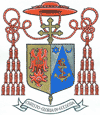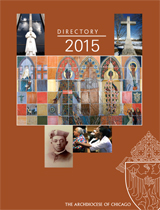
The Cardinal’s Column
Francis Cardinal George, O.M.I.
September 16, 2007
We pray … through Christ Our Lord
Cardinal George's Schedule
- Sept. 16: 11 a.m., 50th Anniversary Mass, Our Lady of Hope, Rosemont; 3 p.m., 50th Anniversary Mass, Holy Trinity School at Notre Dame de Chicago Parish
- Sept. 17: 7:30 a.m., John Paul II Newman Center Board of Directors Meeting; noon, Catholic University Presidents Luncheon, DePaul University
- Sept 18: 9 a.m., school Mass, St. Martin De Porres High School, Waukegan; 5:30 p.m., Rerum Novarum Award Reception
- Sept. 19: 10 a.m., Episcopal Council Meeting
- Sept. 20: 5:30 p.m., Catholic Campaign for Human Development Awards, Old St Mary’s
- Sept. 21: 11:30 a.m., Mass with Priests celebrating their 50th Anniversary of Ordination, Mundelein Seminary; 7 p.m., Catholic Charities 2007 Gala of the Arts, Harris Theater, Millennium Park
- Sept. 22: 2 p.m., Catholic Church Extension Society Lumen Christi Award Reception, Residence; 5:15 p.m., Lumen Christi Award Mass, Holy Name Cathedral
- Sept. 23: 9 a.m., Sunday Mass, St. Nicholas, Evanston; 2:30 p.m., 100th Anniversary Mass, Good Shepherd Parish
- Sept. 25: 5:30 p.m., Patrons of the Arts in the Vatican Museums Reception, the Residence
- Sept. 26: 9:30 a.m., School Mass, St. Pascal; 6:00 p.m., Guest House Dinner, Westin Chicago
- Sept. 27: 10 a.m., Catholic Charities Dedication of Pope John Paul II Residence for Persons with Disabilities, Chicago; 6 p.m., Lumen Cordium Society Cardinal’s Guild Dinner, Residence
- Sept. 29: 9 a.m., Archdiocesan Women’s Committee Meeting, Pastoral Center; 6 p.m., Mass, St. Raphael the Archangel, Antioch

Cardinal's Appointments
September 7 , 2007
His Eminence, Francis Cardinal George announces the following appointments:
Pastor
Rev. Thomas E. Hickey, from pastor of St. Clement Parish, West Deming Place, to be the pastor of Our Lady of Perpetual Help Parish, Glenview, effective immediately.
Pastor emeritus
Rev. John Flavin, from Pastor of Our Lady of Perpetual Help, Glenview, to retire after 46 years of service to the Church and be Pastor Emeritus of the same, effective immediately.
The Archbishop’s residence at State and North has a chapel, as has every bishop’s residence. It was fashioned by Cardinal Mundelein from a waiting room that was part of the house when it was built by Archbishop Feehan in 1882. Every morning, Mass is celebrated in the chapel by myself or one of the priests who live in the residence. The Sisters who take care of the house and those who live here attend that Mass, but the Sisters also use the chapel during the day to come together to pray. The priests use it for visits to the Blessed Sacrament. Sometimes I pray there late at night, after going through the mail or watching the late news on TV. All the prayers said there, whether in the liturgy or in personal prayer, are offered in the name of Christ.
Why is Christian prayer always offered “through, with and in” Christ, as the prayer at the end of the Eucharistic canon puts it? Because the entire life of a disciple of Christ is bound up with Jesus’ life, death and resurrection. In baptism, through the power of the Holy Spirit, Christ gives us his relationship to the Father, whom we therefore dare to call “our” Father in prayer. Christ himself says that our relationship to him takes precedence over any other relationship in our lives. To live “in Christ” is to become more and more like him, more and more configured to him through the action of his grace in our lives.
If both prayer and life are so stamped by Jesus, we had better have a good understanding of who he is. Pope Benedict XVI published a book a few months ago to help us have an accurate picture of “Jesus of Nazareth,” which is the title he gave his book (Doubleday, 2007). His is an unusual book for a Pope to write because, while it is about Gospel truth, it makes no claim to being “official.” Benedict is writing only as a teacher of theology, not as a pastor of the Church. He addresses forthrightly the Scriptural witness to Christ’s identity and declares, on this basis, that Jesus is unequivocally God and knew himself to be divine. More than Moses, who knew God “face to face,” Jesus of Nazareth is and claims to be Son of God from all eternity, one with the Father. The New Testament portrait of Jesus of Nazareth is as original and challenging as the Old Testament portrait of the God of Abraham, Isaac and Jacob. Why shouldn’t it be, for the Son is one with the Father?
Pope Benedict’s book moves around some common presuppositions of Scriptural interpretation in the past 150 years. The distinction between the Jesus of history and the Christ of faith, which set off the interminable and futile “search” for the historical Jesus somewhere behind Christian doctrine, isn’t supported by Scripture itself, nor is the presupposition that the Gospels were really written by anonymous communities arguing with their opponents rather than by the apostolic authors who wanted to bear written witness to what God had revealed in Jesus of Nazareth. This means, first of all, that Jesus is the Person we encounter in the Church and most everything else said about him is the product of an author’s fervid imagination. Secondly, it means that Christ did not come to the world primarily to bring peace or well being for all or to create a better world, good though all these might be; rather, Christ came to bring God and the truth about him. Jesus is not a set of theses, known only to the enlightened few, but a master to be followed.
In following Jesus, we come to know God and to discover that God is love. The best way to study Scripture, therefore, is to use it for prayer and move on to consider the questions faith itself puts to us when we immerse ourselves in the Scriptural witness to Jesus and his works. Faith tells us that Jesus of Nazareth is Son of God, Son of the Virgin Mary, savior of the world and head of his body, the Church. That is why we pray in his name, gather in his Church and live his life in the world. While mere knowledge of who Jesus is does not guarantee friendship with him (the devil knows who Jesus is), a false understanding of Jesus, a theory about his identity that is inadequate to the doctrines of the faith, will destroy a person’s prayer life.
Another book on Christ, perhaps more accessible to readers who might find Joseph Ratzinger’s synthesis about Jesus’ identity a bit heavy going, has been recently published by Msgr. Francis D. Kelly, a well known teacher of the faith. “Discovering Christ: an Inquiry and Meditation” (Our Sunday Visitor, 2007) declares its purpose from the start: “Recent popular books and movies have presented as historical fact allegations about Christology that are patently erroneous and even slanderous. Many persons with little Scriptural, theological or historical understanding of their faith have been confused or deceived. All this indicates the need for a mature, factual, adult understanding of the truth about Christ. Hopefully, this book will make a contribution to that goal.”
The goal of prayer itself is to make us saints, whether our prayer is one of silent adoration or a request for what we need. Illiterate people have become saints because they came to know Christ in the proclamation of the Gospel and its explanation in good homilies and catechetical instruction and in religious art and music and then reflected on all they had been told and seen or heard. These reflections, at their best, became prayer. Literate people become saints in the same way, with the added advantage that they can read Scripture, at least in translation, and ponder books that explain who Jesus is. Whoever becomes a Christian saint does so, however, on the basis of their lived knowledge and love of Jesus of Nazareth.
To pray to become a saint is to pray to live ever more profoundly “through, with and in” Christ. That’s my prayer for you in my chapel. Let that be our prayer for one another “through Jesus Christ, Our Lord.” God bless you.
Sincerely yours in Christ,
Francis Cardinal George, OMI
Archbishop of Chicago
 Catholic
New World - Newspaper for the Archdiocese of Chicago
Catholic
New World - Newspaper for the Archdiocese of Chicago Archdiocese of Chicago Directory
Archdiocese of Chicago Directory Oficjalne wydawnictwo Archidiecezji Chicago w języku polskim
Oficjalne wydawnictwo Archidiecezji Chicago w języku polskim